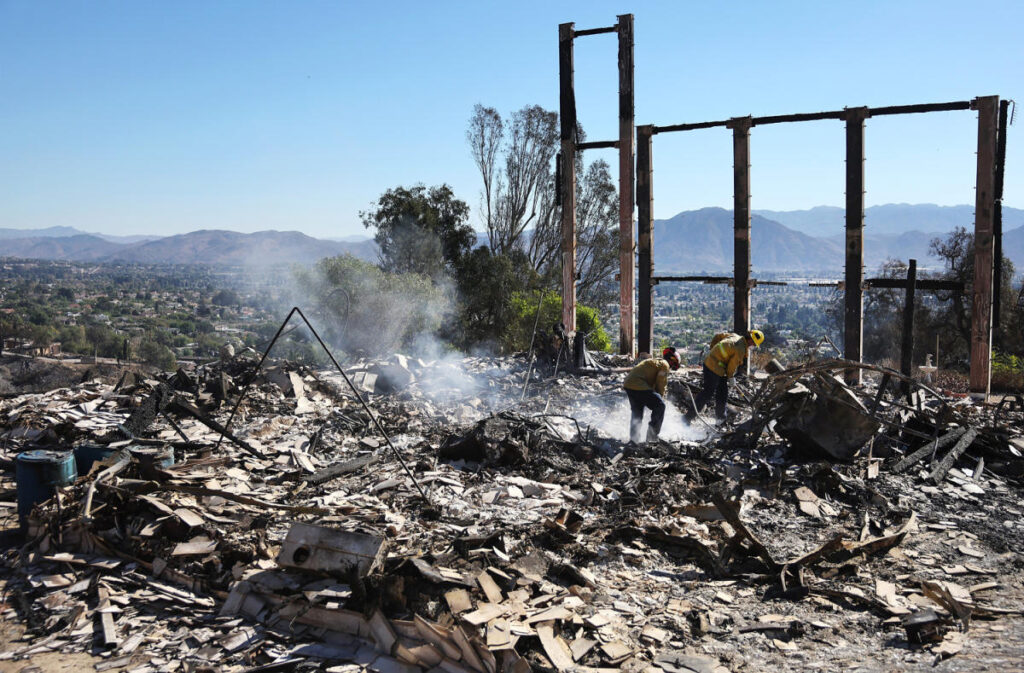California firefighters faced significant challenges due to the Mountain Fire, which threatened communities and led to evacuation orders affecting thousands of residents. As of Friday evening, the fire had burned over 20,000 acres, but favorable weather conditions, including calmer winds, allowed firefighters to make progress in containing the blaze, achieving 14% containment by day’s end. Ventura County Fire Chief Dustin Gardner noted that the fire’s movement had slowed significantly, marking a positive development in the battle against the flames. The fire, located in the Santa Susana Mountains, had resulted in the destruction of numerous homes and structures, with officials actively engaged in monitoring hotspots and conducting damage assessments.
With evacuation orders in place for 5,500 homes, the situation has begun to improve as officials lifted orders for 3,500 properties, allowing some residents to return, contingent on safety inspections. Ventura County Sheriff James Fryhoff reported that environmental checks and cadaver dog searches were needed for the returning residents, although no missing people had been reported. The affected areas are home to approximately 40,000 individuals, illustrating the fire’s potential impact on the local population. Animal shelters were established to care for an array of livestock and pets displaced by the fire, indicating the broader effects of the disaster on the community.
While firefighters worked tirelessly, the fire had already wreaked havoc, destroying 132 structures and leaving 10 people injured, including some firefighters. The assessment of damages was ongoing, with officials unable to provide a comprehensive tally of the total impacted structures. Community members shared their harrowing experiences, describing near escapes from burning residences and the loss of cherished homes, while emphasizing their gratitude for survival. Firefighters used their vehicles to help evacuate residents, highlighting the risks faced by both the community and the first responders in their efforts to safeguard lives and property.
The fire’s rapid spread was exacerbated by harsh weather conditions, including warm and dry offshore winds that fueled its growth. High gusts were recorded shortly after the fire ignited, with emergency declarations and resources being deployed swiftly to combat the blaze. Governor Gavin Newsom declared a state of emergency, facilitating access to federal assistance through FEMA to support local firefighting efforts. A massive contingent of approximately 2,420 personnel, assisted by air support and numerous firefighting engines, was mobilized to control the flames and protect vulnerable areas.
As the situation unfolded, changes in weather patterns brought some relief. By Friday, wind gusts had diminished significantly, with meteorological assessments indicating more stable conditions. The expiration of red flag warnings signified a decrease in the immediate risk of new fire outbreaks. However, uncertainties remained regarding the sustainability of improving weather, with potential light rain on the horizon but also the risk of warm, dry conditions returning later in the week. Fire officials drew parallels between the Mountain Fire and previous major incidents, such as the 2018 Woolsey Fire, emphasizing the importance of vigilance and ongoing efforts to prevent further damage.
In conclusion, the Mountain Fire posed a serious threat to California residents and wildlife, prompting large-scale evacuation measures and emergency responses. As firefighters continued their arduous battle against the flames, the community showed resilience in the face of adversity, sharing stories of survival and gratitude. Improving weather conditions provided a glimmer of hope as containment efforts progressed, though officials remained cautious about the forecasted climate changes. The collaborative efforts of local agencies, state authorities, and federal resources demonstrated the coordinated response necessary to manage such natural disasters, underscoring the ongoing challenges of wildfire management in California’s diverse landscapes.

